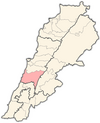| Chouf District جبل الشوف | |
|---|---|
| District | |
 Chouf Mountains Chouf Mountains | |
 Location in Lebanon Location in Lebanon | |
| Coordinates: 33°41′44″N 35°34′49″E / 33.69556°N 35.58028°E / 33.69556; 35.58028 | |
| Country | |
| Governorate | Mount Lebanon Governorate |
| Capital | Beiteddine |
| Area | |
| • Land | 191 sq mi (495 km) |
| Population | |
| • Estimate | 231,427 |
| Time zone | UTC+2 (EET) |
| • Summer (DST) | UTC+3 (EEST) |
Chouf (also spelled Shouf, Shuf or Chuf; Arabic: جبل الشوف, romanized: Jabal ash-Shouf) is a historic region of Lebanon, as well as an administrative district in the governorate (muhafazat) of Mount Lebanon.
Geography
Located south-east of Beirut, the region comprises a narrow coastal strip notable for the Christian town of Damour, and the valleys and mountains of the western slopes of Jabal Barouk, the name of the local Mount Lebanon massif, on which the largest forest of Cedars of Lebanon is found. The mountains are high enough to receive snow.
History
See also: History of the Chouf region


The Emirs of Lebanon used to have their residence in Chouf, most notably Druze Emir Fakhr al-Din II, who attained considerable power and acted with significant autonomy from the Ottoman Empire in the 17th century. He is often referred to as the founder of modern Lebanon, although his area of influence and later control also included parts of occupied Palestine and Syria. Other emirs include Bachir Chehab II, who built the palace of Beiteddine during the first half of the 19th century whose policies inaugurated the modern Lebanese state. Another historical town, just facing Beiteddine, is Deir al Qamar (the monastery of the Moon).
The relationship between the Druze and Christians in Chouf has been characterized by harmony and peaceful coexistence. The Maronite Catholics and the Druze founded modern Lebanon in the early eighteenth century, through the ruling and social system known as the "Maronite-Druze dualism" in Mount Lebanon Mutasarrifate.
Chouf is the heartland of the Lebanese Druze community, with Druze leader Walid Jumblatt residing at the Jumblatt palace in the town of Moukhtara. Several violent clashes have occurred between Druze and Christians, as in 1848, 1860 and most recently 1983-1984, during the Lebanese Civil War (Mountain War, Arabic: Harb el-Jabal). At the end of January 1989 Walid Jumblatt launched an initiative to help Christians return to their mountain homes. An estimated 300,000 Christians had abandoned their properties during the fighting. The initiative was supported by Dany Chamoun. The plan was withdrawn 5 March following General Aoun’s blockade of the Druze port at Jieh, his subsequent shelling of Souq El Gharb and the assassination of one of Jumblatt’s top aides. Reconciliation between the Druze and Christian communities came to fruition on August 8, 2001, when the Maronite Patriarch of Antioch, Cardinal Mar Nasrallah Boutros Sfeir made a historic visit to the Chouf and met with the Druze and Chouf leader, Walid Jumblatt.
On 28 February 1989 an Israeli air-strike on the Chouf killed three school children and damaged their school. Twenty-two others were wounded. It was the third IAF attack on Lebanon since the beginning of the year.
The Chouf is one of the best-preserved Lebanese districts, and its nature has been generally spared from the intense building of neighboring Metn and Kesrouan.
Demographics
Despite the historical feuds between Sunni Muslims and Christian Maronites and Druze, the Chouf district is still one of the most religiously diverse regions in Lebanon. Currently, the region hosts equal proportions of Druze, Sunni Muslims, and Christians (Maronite and Greek Catholic) populations. As of 2022, the religious make-up of the District's 212,512 voters were roughly 31% Druze, 30% Sunni, 27% Maronite Catholics, 6% Greek Catholic, 3% Shia, and 3% others.
Druze (31%) Sunni (30%) Maronite Catholics (27%) Greek Catholic (6%) Shia (3%) Others (3%)Notable cities and towns
- Ainbal
- Ain Zhalta
- Ammatour
- Aanouth
- Baadarâne
- Baakline
- Barja
- Barouk
- Batloun
- Beitedine
- Bourjain
- Brih
- Bsaba
- Chhime
- Dahr El Maghara
- Damour
- Daraya
- Deir el Qamar
- Dibbiyeh
- Dmit
- Gharife
- Haret Jandal
- Fouara
- Jahlieh
- Jdaideh
- Jiyyeh
- Joun
- Kahlouniye
- Kfarfakoud
- Moukhtara
- Na'ameh
- Niha Chouf
- Rmeileh
- Serjbel
- Shheem
- Zaarourieh
See also
- Iqlim al-Kharrub, historical region located in the Chouf District
References
- Panagakos, Anastasia (2015). Religious Diversity Today: Experiencing Religion in the Contemporary World : Experiencing Religion in the Contemporary World. ABC-CLIO. p. 99. ISBN 9781440833328.
- ^ Hazran, Yusri (2013). The Druze Community and the Lebanese State: Between Confrontation and Reconciliation. Routledge. p. 32. ISBN 9781317931737.
the Druze had been able to live in harmony with the Christian
- Deeb, Marius (2013). Syria, Iran, and Hezbollah: The Unholy Alliance and Its War on Lebanon. Hoover Press. ISBN 9780817916664.
the Maronites and the Druze, who founded Lebanon in the early eighteenth century.
- Middle East International No 343, 3 February 1989, Publishers Lord Mayhew, Dennis Walters MP; Jim Muir pp.3,4
- Middle East International No 346, 17 March 1989, Publishers Lord Mayhew, Dennis Walters MP; Jim Muir pp.6,7
- Middle East International No 346, 17 March 1989, Publishers Lord Mayhew, Dennis Walters MP; Jim Muir pp.6,7; also p.8 Fourteen days in brief
- "Mapping Lebanon: Data and statistics".
